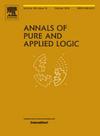Transposition of variables is hard to axiomatize
IF 0.6
2区 数学
Q2 LOGIC
引用次数: 0
Abstract
The function that interchanges two logical variables in formulas is hard to describe in the following sense. Let F denote the Lindenbaum–Tarski formula-algebra of a finite-variable first-order logic, endowed with as a unary function. We prove that each equational axiom system for the equational theory of F has to contain, for each finite n, an equation that contains together with at least n algebraic variables, and each of the operations . This gives an answer to a problem raised by Johnson (1969) [30]: the class of representable polyadic equality algebras of a finite dimension cannot be axiomatized by adding finitely many equations to the equational theory of representable cylindric algebras of dimension α. Consequences for proof systems of finite-variable logic and for defining equations of polyadic equality algebras are given.
The proof uses a family of nonrepresentable polyadic equality algebras that are more and more nearly representable as n increases: their n-generated subalgebras as well as their proper reducts are representable. The lattice of subvarieties of is investigated and new open problems are asked about the interplay between the transposition operations and about generalizability of the results to infinite dimensions.
变量的变换是很难公理化的
在公式中交换两个逻辑变量x,y的函数pxy很难用下面的意义来描述。设F表示有限变量一阶逻辑的Lindenbaum-Tarski公式代数,赋予pxy为一元函数。我们证明F的方程理论的每个方程公理系统必须包含,对于每一个有限n,一个方程与pxy至少包含n个代数变量,并且每个操作∃,=,∨。这就回答了Johnson(1969)[30]提出的一个问题:有限维α≥3的可表示多进代数类RPEAα不能通过在α维可表示圆柱代数的方程理论中添加有限多个方程来公理化。给出了有限变量逻辑的证明系统和定义多进等式代数方程的结果。该证明使用了一组随着n的增加而越来越接近可表示的不可表示的多进相等代数:它们的n生成子代数和它们的适当约化都是可表示的。研究了RPEAα的子变格,并提出了一些新的开放问题,包括转置运算之间的相互作用和结果在无限维上的可推广性。
本文章由计算机程序翻译,如有差异,请以英文原文为准。
求助全文
约1分钟内获得全文
求助全文
来源期刊
CiteScore
1.40
自引率
12.50%
发文量
78
审稿时长
200 days
期刊介绍:
The journal Annals of Pure and Applied Logic publishes high quality papers in all areas of mathematical logic as well as applications of logic in mathematics, in theoretical computer science and in other related disciplines. All submissions to the journal should be mathematically correct, well written (preferably in English)and contain relevant new results that are of significant interest to a substantial number of logicians. The journal also considers submissions that are somewhat too long to be published by other journals while being too short to form a separate memoir provided that they are of particular outstanding quality and broad interest. In addition, Annals of Pure and Applied Logic occasionally publishes special issues of selected papers from well-chosen conferences in pure and applied logic.

 求助内容:
求助内容: 应助结果提醒方式:
应助结果提醒方式:


